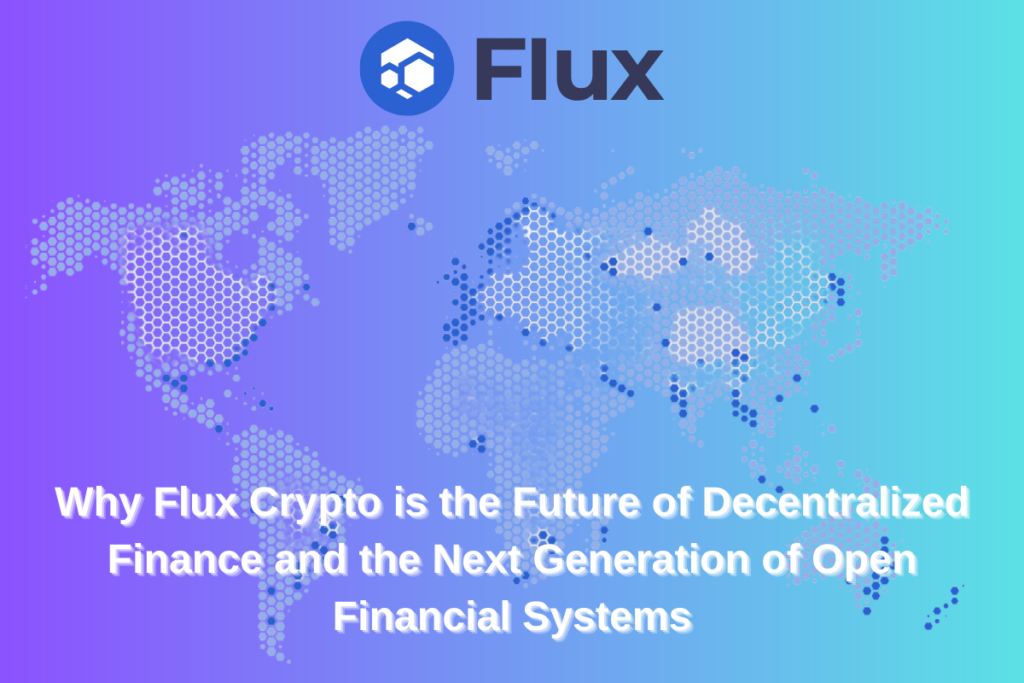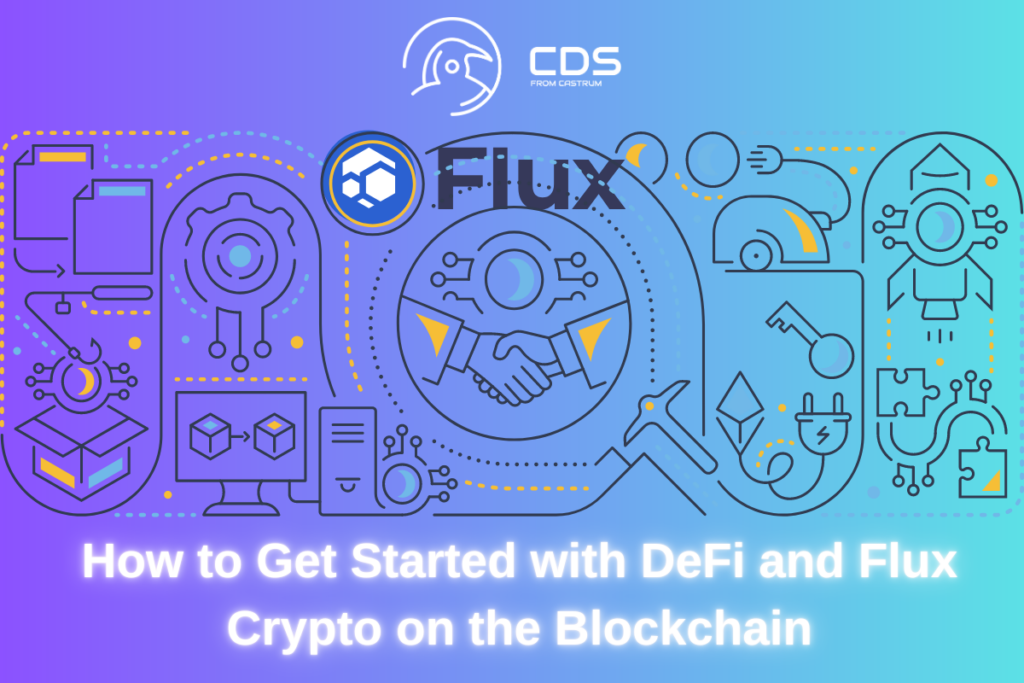Why Flux Crypto is the Future of Decentralized Finance and the Next Generation of Open Financial Systems
Flux is a next generation scalable decentralized cloud infrastructure. Easily develop, manage and run your applications on multiple servers at the same time. Ready for Web 3.0, Dapps and more.
The Flux ecosystem is a fully functional set of decentralized computing services and blockchain-as-a-service solutions that offer an interoperable, decentralized development environment similar to AWS.
The ecosystem consists of the following components, which are fully deployed and operational:
Flux, a native GPU-mineable POW (Proof of Work) coin, provides an incentive for hardware hosters, DAO management on the network, and mitigation for attackers through staking requirements for live hardware.
Next generation Web3 decentralized computing network with over 2600+ Flux nodes located worldwide, providing approximately 12,850+ virtual cores of CPU power, 40+ terabytes of RAM and 975+ terabytes of storage. Anyone can set up a Flux Node anywhere in the world as long as they provide the necessary Flux software and hardware for one of the three levels of the Flux Node.
Flux Nodes can be run on Raspberry Pi/Home PC/Servers/VPS hardware from anywhere in the world. Flux node operators are rewarded with Flux block rewards, but can also earn other cryptocurrencies by hosting certain dapps on their nodes.
FluxOS An operating system running on top of Linux to manage the network by testing and benchmarking computing power, deploying, running and load balancing decentralized applications, managing XDAO governance, and more. Any secure dockerized application can be deployed through FluxOS and the network, which currently hosts over 30 decentralized applications, including blockchain infrastructure, social media, data oracles, websites, games, and file storage.

Parallel Chain Interoperability is a DeFi bridge that provides access to major decentralized exchanges. Provide interoperability with other blockchains and access to DeFi.
Zelcore is the official Flux wallet, which is a premium multi-asset wallet for PC and mobile devices with integration of major centralized and decentralized exchanges into the wallet.
Flux is an open, community-driven and independent project without any external investors. So $Flux is fairly distributed without any pre-mined coins or distributions to others other than holders, miners and node operators. The project is firmly committed to building a true decentralized future by remaining independent and constantly striving for innovation and breakthroughs in blockchain technology.
The economic model of Flux strongly incentivizes holders, GPU miners, and node operators through airdrops, mining rewards, and nodes. Node operators can also earn additional cryptocurrencies through paid partnerships and paid application hosting.
The flow price today is ₽129.78 rubles. with a daily trading volume of ₽2,996,151,295 This update it FLUX to RUB price in real time. The flow is down 5.87 in the last 24 hours. The current CoinMarketCap rating is #150 with an income capitalization of RUB29,367,032,947. The circulating supply is 226,274,780 FLUX coins and max. offer of 440,000,000 FLUX coins.
The Benefits of Using Flux Crypto for a Decentralized Financial System
Flux is a decentralized Web3 cloud infrastructure comprised of user-operated, scalable and globally distributed computational nodes.
Flux is the new generation of scalable decentralized cloud infrastructure. Simply develop, manage, and spawn your applications on multiple servers at once. Ready for Web 3.0, Dapps, and more.
The Flux Ecosystem is a fully-operational suite of decentralized computing services and blockchain-as-a-service solutions which offer an interoperable, decentralized, AWS-like development environment.
The Ecosystem consists of the following components which are all fully deployed and operational:
Flux a native GPU mineable POW (Proof of Work) coin providing incentive for hardware hosters, DAO governance on-chain, and bad actor mitigation via staking requirements for running hardware.
Next Generation Decentralized Web3 Computational Network with more than 2600+ Flux nodes located all around the globe providing around 12,850+ vCores of CPU power, 40+ terabytes of RAM and 975+ terabytes of storage. Anyone can stand up a Flux Node anywhere in the World, if they provide the required Flux collateral and hardware for one of three Flux Node tiers.
Flux Nodes can be run on Raspberry Pi/Home PC/Servers/VPS hardware from anywhere in the world. Flux node operators are rewarded with Flux through block rewards, but are also able to earn other cryptocurrencies by hosting specific dapps on their nodes.
FluxOS An operating system running on top of Linux to manage the network by verifying and benchmarked compute power, deploying, running and load balancing decentralized applications, managing XDAO governance and more. Any hardened dockerized app can be deployed via FluxOS and the network currently hosting more than 30 dapps including blockchain infrastructure, social media, data oracles, websites, games and file storage.
Parallel Chain Interoperability a DeFi bridge providing accessibility to major decentralized exchanges. Provide interoperability with other blockchains and DeFi access.
Zelcore the official Flux wallet that is a premiere multi-asset, self-custodial wallet for PC and mobile with in-wallet integration of major centralized and decentralized exchanges.
Flux is an open-source, community driven and independent project without any outside investors. As such $Flux is fairly distributed without any pre-mined coins or distributions for others than holders, miners and node operators. The project is highly committed to building a true decentralized future by staying independent and continually pushing for innovation and disruption in blockchain technology.
The Flux economic model highly incentivizes holders, GPU miners and node operators through airdrops, mining and node rewards. Node operators are also able to earn additional cryptocurrencies through paid partnerships and paid app hosting
Flux is the new generation of scalable decentralized cloud infrastructure. Simply develop, manage, and spawn your applications on multiple servers at once. … The Flux ecosystem is made up of a number of different moving parts. FluxOS and FluxNodes provide the computational network, zelcore is the wallet with built in apps to power the wider ecosystem, the Flux blockchain is used to fund the ecosystem and the Flux parallel assets provide interoperability with other blockchains.
Flux is the new generation of scalable decentralized cloud infrastructure. Simply develop, manage, and spawn your applications on multiple servers at once. Ready for Web 3.0, Dapps, and more.
How to Get Started with DeFi and Flux Crypto on the Blockchain

Decentralized finance (DeFi) has gained significant popularity as an alternative financial system built on blockchain technology. Flux Crypto, a prominent cryptocurrency in the DeFi space, offers exciting opportunities for users to participate in this decentralized ecosystem. If you’re interested in getting started with DeFi and Flux Crypto, here’s a step-by-step guide to help you navigate the process:
- Educate Yourself: Start by gaining a solid understanding of DeFi and how it works. Research the concepts of decentralized applications (DApps), smart contracts, and blockchain technology. Familiarize yourself with Flux Crypto and its unique features within the DeFi landscape.
- Set Up a Wallet: To interact with Flux Crypto and other DeFi platforms, you’ll need a cryptocurrency wallet. Choose a reputable wallet that supports Flux Crypto and offers robust security features. Popular options include MetaMask, Trust Wallet, and Ledger.
- Acquire Flux Crypto: Obtain Flux Crypto by purchasing it from a cryptocurrency exchange. Look for reputable exchanges that list Flux Crypto and complete the necessary registration and verification processes. Once your account is set up, deposit funds, and exchange them for Flux Crypto.
- Secure Your Crypto: Transfer your acquired Flux Crypto to your personal wallet for enhanced security. Follow the wallet’s instructions to create a wallet address and initiate the transfer from the exchange to your wallet. Remember to keep your private keys secure and never share them with anyone.
- Explore DeFi Platforms: With Flux Crypto in your wallet, you’re ready to explore various DeFi platforms. These platforms offer a range of financial services, such as lending, borrowing, staking, yield farming, and decentralized exchanges. Some popular DeFi platforms include Uniswap, Compound, Aave, and Yearn.finance.
- Conduct Due Diligence: Before engaging with any DeFi platform, conduct thorough research to understand its features, risks, and potential rewards. Check the platform’s reputation, security measures, and user feedback. Ensure you’re comfortable with the platform’s terms and conditions before participating.
- Start Small: Begin your DeFi journey by starting with small investments or transactions. This allows you to familiarize yourself with the platform’s interface, functionalities, and risks while minimizing potential losses. As you gain experience and confidence, you can gradually increase your participation.
- Stay Updated: DeFi and Flux Crypto are rapidly evolving, with new projects and updates regularly entering the market. Stay informed about the latest developments, news, and security best practices. Follow reputable sources, join relevant communities, and engage in discussions to expand your knowledge.
Remember, while DeFi offers exciting opportunities, it also carries risks. Be mindful of potential scams, smart contract vulnerabilities, and market volatility. Only invest what you can afford to lose and consider seeking professional advice if needed.
By following these steps and exercising caution, you can embark on your DeFi journey with Flux Crypto and experience the potential benefits of this innovative decentralized financial system.
Disclaimer: The information provided here is for informational purposes only and should not be considered financial or investment advice. Always do your own research and exercise caution when participating in the DeFi ecosystem.
















Leave a comment